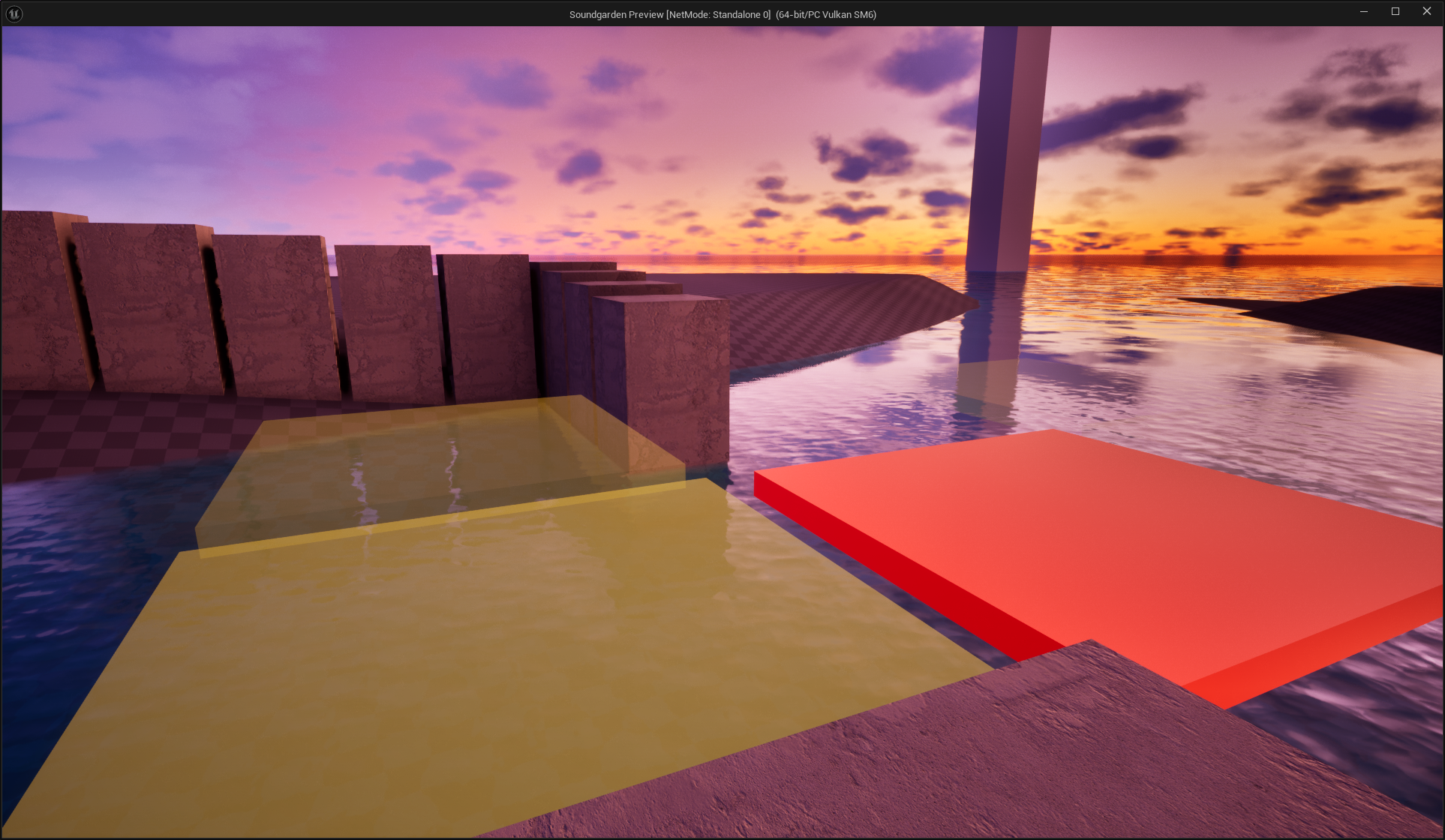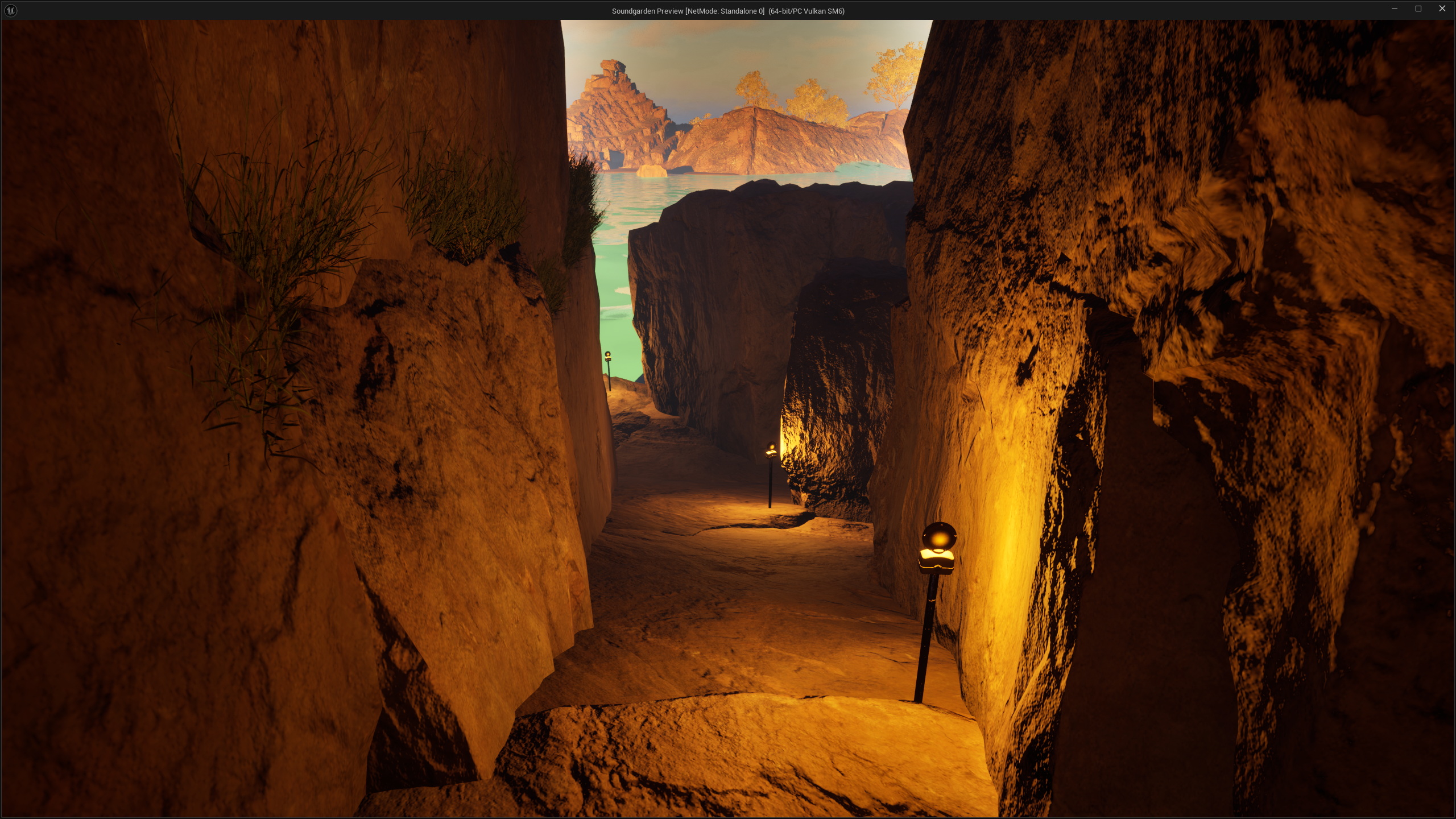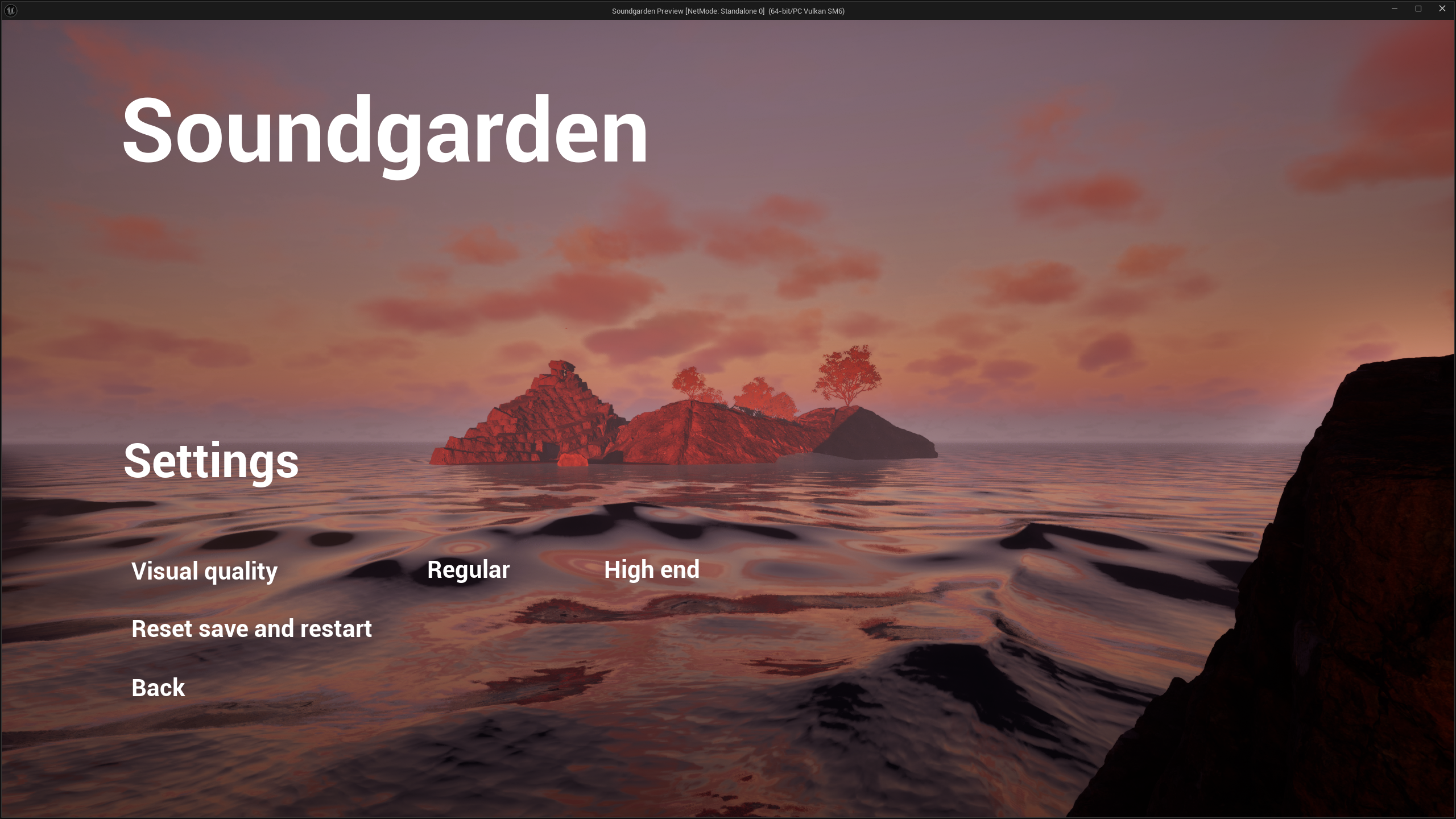soundgarden
Sound gates 🚪
The latest gameplay to feature in Soundgarden is called Sound gates and is an implementation of the “odd one out” mechanic I brainstormed previously. Here, the player is presented with a selection of gates - 3 at a time in the current prototype - and must identify the gate that emanates a sound different from the others. Walking through the correct gate will lead the player to the next set of gates, or eventually the exit. Walking through an incorrect gate will block the player’s path, requiring them to walk back to the start and start anew. The correct gate is randomized each time the player approaches the area, to make sure the gates are not traversable through trial and error. In the current prototype, only two similar sounds are featured: sine wave and triangle wave. If two gates are playing a sine wave, the correct gate will be marked by a triangle wave and vice versa.
However, I plan to add more differences in sound features in the future. In addition to timbre, the sounds could also differ in pitch or feature slightly differing repeating patterns. I’m also thinking about a progression in difficulty. When using pitch, the odd pitch could at first be represented by a clearly audible interval, which could then be reduced as the player progresses, until the differences in pitch are so miniscule they might require very close and concentrated listening. Same goes for timbre. For example, the sound gates could feature more subtle timbral differences. Instead of pointing out a triangle wave vs. a sine wave, the gates could feature sound waves that are morphed between the two types, leading to more gradual differences. The gates could also feature melodies, where the odd one might feature one different note in the sequence, requiring the player to spend more time listening and memorizing in order to be able to tell a difference. As we can see here, while the mechanic seems simple, there are many variations to play with!
Another recap 🔁
Another year is coming to an end and with it this project… at least for the remainder of this year, as I will be enjoying the holiday season. I am yet to finish phase 2 which focuses on the sound-led island. While I’m happy with how the second island is coming together, there are still more sound-led game mechanics to add. Nevertheless, I would like to recap what happened in this project since I took it up again back in September.
Inspired by the insights I gained researching sound-led games, I developed three gameplay mechanics.
First, the rhythm grid that requires the player to traverse platforms moving to a beat. This seems to be the most straightforward mechanic and is close to what we have seen in many rhythm-based games. While testers reported the traversal to be a bit tricky at times (for example, because the rhythm was too fast), the mechanic was easily understood. I still need to integrate this mechanic into island 2, since it currently only exists as a grey box prototype. Integrating the rhythm grid into the game environment will require me to rethink the floating transparent platforms in favor of something that better fits the natural rocky environment.

Second, the wind path mechanic where players must follow the sound of the wind to reach the exit of a dark tunnel. While I’m personally very happy with how it turned out, being able to easily navigate the tunnel by ear, testers found it far more difficult. On the one hand, there were difficulties in understanding the mechanic - I will need to work on communicating it better. On the other hand, even when testers understood the function of the wind, the provided sonic information did not seem to be enough for most people to get a clear sense of direction. There is clearly more work to be done here. Of the three mechanics listed here, this is the only one that is already integrated on island 2.

Third, the sound gates, that I described above. I am yet to see what testers will think about it. However, I have a feeling that it will be easier to understand - and perhaps easier to solve - than the wind path mechanic.

I still plan to add one or two more sound-led mechanics to island 2. Once they are all integrated and playable for most people, phase 2 will be done and I will move on to work on interactions where players can affect sound. Instead of creating a third island, as I had planned originally, I will build a lagoon that will connect islands 1 and 2 and feature these interactions.
Beyond the new island and its game mechanics, I have also implemented some general improvements for Soundgarden.
First, I fixed some issues with the sound speakers on island 1, making for a fuller soundscape. I have also added a main menu that allows for changing the graphics settings. This was part of my effort to improve Soundgarden’s performance. Stemming from this effort is a slight graphics downgrade which led to a massive performance improvement. However, the previous graphics setting can now be selected in the settings menu. Further, we now have save games! This means that players do not need to replay the tutorial every time anymore, which especially makes sense as the world grows, featuring more areas and things to do. Implementing save games took some considerable effort in debugging, since I had to account for the dynamic day-night cycle, player location, and progression (e.g., the amount of collected stones). This required me to refactor the logic for the tutorial and move away from some hard-coded approaches. With the save game system in place, I will need to make sure any new gameplay additions are reflected by the saving system when required.

As the project grows, I will also have to take up old habits. Specifically, I will need to use to-do lists and my light agile approach, in order to track new features and bug fixes. I also want to make the game accessible to more players by supporting OSX and Linux. Recently, I have tested a Mac build that, surprisingly, ran quite decently on my M1 MacBook Air. Still, there are some shader issues I need to fix before adding this version. Once this is done, I have a feeling it will be rather trivial to also make a Linux build as well.
All in all, I’m happy with how the previous months went. I have gained many insights into sound-led game design. I now also have a much better grasp of Unreal Engine and have come to enjoy its paradigms. I know my way around now, to the point that problem solving has become an interesting challenge, rather than some buggy nightmare. Whenever I have a new idea now, I can focus on its implementation, unbothered by the ins and outs of UE5. I learned new systems, such as the procedural generation tool, and I learned how to customize the engine for my needs by creating custom data types and writing my own blueprint nodes in C++. I also know how to do things the right way, which has helped me in fixing old issues, such as the sound speakers on island 1.
I am excited to see where this project is going, and, sometime in summer 2025, how it will all look and sound once it’s done!